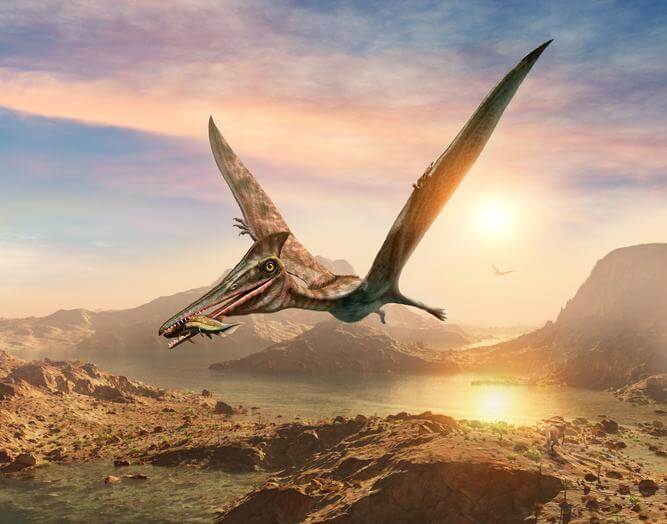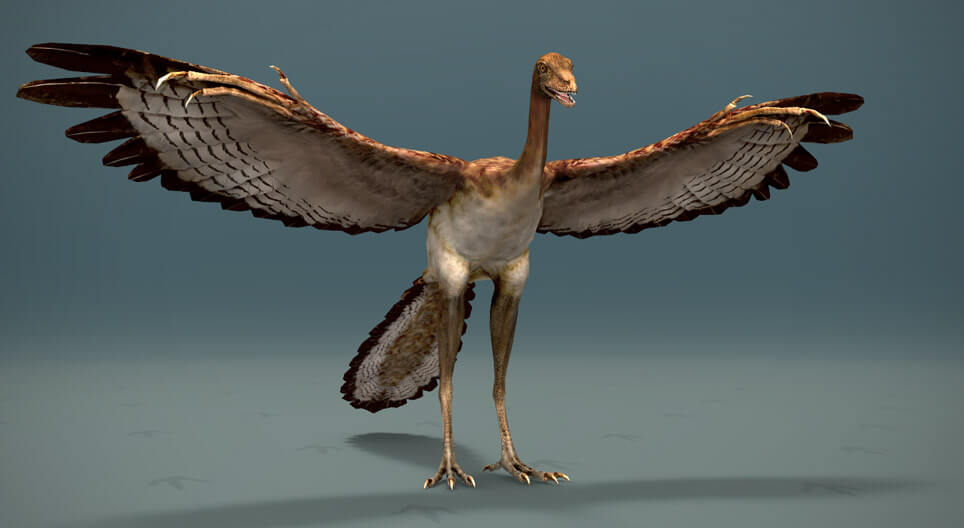10 Types of Flying Dinosaurs

Dinosaurs were the supreme rulers of the Earth, at least from the Triassic to the Cretaceous period. Although these “terrible lizards” were mostly terrestrial, others developed the ability to conquer the air. In this way, and in spite of the fact that they weren’t so specialized, several types of flying dinosaurs appeared, which coexisted directly with their terrestrial cousins.
In the following lines, the term “flying dinosaurs” is used to refer to some theropods (avians) and pterosaurs. The clarification is made because, formally, although the first group is classified as dinosaurs, the second is more of a close cousin. Even so, because both coexisted with these giant reptiles, they’re grouped together to create the following list of flying dinosaurs.
What were the flying dinosaurs?

Strictly speaking, dinosaurs are a group of ancient reptiles, whose characteristics are subtle but distinguishable from other organisms. This is important for specialists, because it allows them to group them according to their appearance. In a general sense, we can select the 2 main features of dinosaurs.
- The shape of the pelvis: This feature allows them to have an upright and bipedal posture, contrary to modern-day reptiles, whose limbs are inserted to the sides. This subdivides the group into Saurischia and Ornithischia.
- Temporal fossettes: To put it simply, these are modifications in the shape of the skull, which make two diapsid orifices appear near where the eyes are located. In fact, this same characteristic makes the jaw muscles so powerful.
This doesn’t mean that these extinct reptiles don’t have other modifications, but these are the most common and the ones that define dinosaurs as we know them.
Flying pterosaurs
As mentioned above, pterosaurs are sauropsids that lived at the same time as dinosaurs, but are not part of this group. The reason behind this is that their bodies were completely adapted to flight, so they weren’t able to walk upright. Thanks to this, they were one of the first groups to take to the skies, but they sacrificed their mobility on the ground.
In general, the general characteristics of these animals were the presence of a crest on their head and a hard-toothed beak. In addition, their upper extremities were excessively elongated, so that their fourth finger was the one that maintained the membrane that allowed them to fly. In addition, the sizes of these beings were variable, but they could compete in height with the size of a modern-day giraffe.
1. Quetzalcoatlus northropi
With wingspans of 10 to 11 meters (33 to 36 feet), this pterosaur was discovered in Texas, thanks to a fragment of its wings. The neck of this animal is quite elongated, and it’s believed to have reached a total height of 5.2 meters (17 feet). For this reason, some consider it to be the largest flying reptile of these times, although it’s still unknown if it was a fierce predator or just a scavenger.
2. Montanazhdarcho minor
Although it’s true that most reptiles of this period were giants, there were also some smaller ones. This is the case of this species, named after the place where it was found, the state of Montana. The epithet “minor” alludes to its small size, since it only had a wingspan of around 2.5 meters (8 feet), which makes it the smallest of its kind.
3. Pteranodon
This is probably the most researched group of pterosaurs, as there are many good-quality fossil records. In fact, before the discovery of specimens such as Quetzalcoatlus, these were considered the largest flying reptiles, exhibiting a wingspan of approximately 5.6 meters (18 feet). The beak of these reptiles had no teeth, so it closely resembled that of present-day birds.
4. Preondactylus
Among flying dinosaurs, it wasn’t very common to find a tail, so this small specimen stood out for having one. As if that weren’t enough, its size was rather unusual too – similar to the size of a pigeon today. This is demonstrated by its small wingspan, spanning only about 45 centimeters (1.5 feet) in total.
5. Aerodactylus scolopaciceps
This species is a very well-studied specimen, as the fossil remains that were found were completely preserved. The mouth of this gigantic reptile had 64 teeth, with a small hooked beak at the end of its jaw. It was also small, with a wingspan of barely 1.1 meters (3.6 feet).
6. Rhamphorhynchus
This belongs to the group of ancient pterosaurs, which used to have an elongated tail with a diamond-shaped rudder. The jaw of this reptile consisted of 34 needle-like teeth, which were interlocked when the mouth was closed. In addition, the size of this specimen was average, with a height of 1.26 meters (4.1 feet) and a wingspan of 1.81 meters (nearly 6 feet).
7. Pterodactylus
This is perhaps the most well-known group, as many references have been made in animated series, movies, and various media. The average wingspan size is estimated at 1.5 meters (nearly 5 feet), although it’s believed that most of them were smaller. The skulls of this animal were long and narrow, but contained 90 conical teeth, which were used to hunt their prey.
Avians
This is the closest group to present-day birds, whose specimens are the first types of feathered reptiles, capable of flying and gliding. In fact, some consider that these animals should no longer be considered dinosaurs. However, because they’re within the order Saurischia, they’re arguably the true flying dinosaurs.
8. Archaeopteryx

This is a primitive animal, considered to be the ancestor or missing link between birds and dinosaurs. The physical form of the archaeopteryx is believed to have been very similar to that of a European magpie, up to half a meter in length (1.6 feet) and fairly broad wings. Despite its size, it’s likely that this organism would have been able to fly actively, something similar to birds today, but only sporadically.
9. Iberomesornis
This type of bird was a more advanced type than the previous one, as its tail was longer and already had the function of a rudder. They were a similar size to a sparrow, with constant flight activity. Moreover, the structure of their legs was already adapted to arboreal habits, since three of their toes were directed forward, and one backwards, to cling to the branches.
10. Ichthyornis
The shape of this feathered reptile is very likely to remind you of today’s seabirds. However, its toothed jaw is the most different aspect, which classifies it as a primitive bird. In fact, because of this similarity, some include it within the bird group and not as part of its ancestors.
As you can see, the list we’ve compiled features a variety of flying dinosaurs, from giant creatures that bear little resemblance to modern-day birds, to their closest ancestors today. In this way, we have summarized the evolutionary changes that flying dinosaurs underwent.
All in all, the conquest of the skies was an arduous process that took millions of years to achieve and that we can now see in action, thanks to the incredible variety of birds on our planet.
All cited sources were thoroughly reviewed by our team to ensure their quality, reliability, currency, and validity. The bibliography of this article was considered reliable and of academic or scientific accuracy.
- Arita, H. T. Baptistina y los dinosaurios. Ciencias, 95(095).
- Witton, M. P., & Naish, D. (2008). A reappraisal of azhdarchid pterosaur functional morphology and paleoecology. PLoS one, 3(5), e2271.
- Averianov, A. O. (2010). The osteology of Azhdarcho lancicollis Nessov, 1984 (Pterosauria, Azhdarchidae) from the late Cretaceous of Uzbekistan. Proceedings of the Zoological Institute RAS, 314(3), 264-317.
- Vidovic, S. U., & Martill, D. M. (2014). Pterodactylus scolopaciceps Meyer, 1860 (Pterosauria, Pterodactyloidea) from the Upper Jurassic of Bavaria, Germany: the problem of cryptic pterosaur taxa in early ontogeny. PloS one, 9(10), e110646.
- Bennett, S. C. (2013). New information on body size and cranial display structures of Pterodactylus antiquus, with a revision of the genus. Paläontologische Zeitschrift, 87(2), 269-289.
- Voeten, D. F., Cubo, J., De Margerie, E., Röper, M., Beyrand, V., Bureš, S., … & Sanchez, S. (2018). Wing bone geometry reveals active flight in Archaeopteryx. Nature communications, 9(1), 1-9.
- Chiappe, L. M., & Vargas, A. (2003). Emplumando dinosaurios: la transición evolutiva de terópodos a aves. Hornero, 18(1), 1-11.
This text is provided for informational purposes only and does not replace consultation with a professional. If in doubt, consult your specialist.